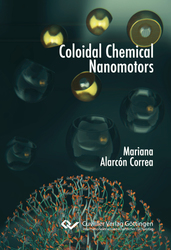| Fachbereiche | |
|---|---|
| Buchreihen (96) |
1378
|
| Nachhaltigkeit |
3
|
| Gesundheitswesen |
1
|
| Geisteswissenschaften |
2364
|
| Naturwissenschaften |
5406
|
| Mathematik | 229 |
| Informatik | 319 |
| Physik | 980 |
| Chemie | 1363 |
| Geowissenschaften | 131 |
| Humanmedizin | 243 |
| Zahn-, Mund- und Kieferheilkunde | 10 |
| Veterinärmedizin | 108 |
| Pharmazie | 147 |
| Biologie | 835 |
| Biochemie, Molekularbiologie, Gentechnologie | 121 |
| Biophysik | 25 |
| Ernährungs- und Haushaltswissenschaften | 45 |
| Land- und Agrarwissenschaften | 1004 |
| Forstwissenschaften | 201 |
| Gartenbauwissenschaft | 20 |
| Umweltforschung, Ökologie und Landespflege | 148 |
| Ingenieurwissenschaften |
1793
|
| Allgemein |
98
|
|
Leitlinien Unfallchirurgie
5. Auflage bestellen |
|
Erweiterte Suche
Colloidal Chemical Nanomotors
Mariana Alarcón Correa (Autor)Vorschau
Leseprobe, PDF (600 KB)
Inhaltsverzeichnis, PDF (75 KB)
Synthetic sophisticated nanostructures represent a fundamental building block for the development of nanotechnology. The fabrication of nanoparticles complex in structure and material composition is key to build nanomachines that can operate as man-made nanoscale motors, which autonomously convert external energy into motion.
To achieve this, asymmetric nanoparticles were fabricated combining a physical vapor deposition technique known as NanoGLAD and wet chemical synthesis.
This thesis primarily concerns three complex colloidal systems that have been developed:
i)Hollow nanocup inclusion complexes that have a single Au nanoparticle in their pocket. The Au particle can be released with an external trigger.
ii)The smallest self-propelling nanocolloids that have been made to date, which give rise to a local concentration gradient that causes enhanced diffusion of the particles.
iii)Enzyme-powered pumps that have been assembled using bacteriophages as biological nanoscaffolds. This construct also can be used for enzyme recovery after heterogeneous catalysis.
| ISBN-13 (Printausgabe) | 9783736997974 |
| ISBN-13 (E-Book) | 9783736987975 |
| Buchendformat | A5 |
| Sprache | Englisch |
| Seitenanzahl | 150 |
| Umschlagkaschierung | glänzend |
| Auflage | 1. |
| Erscheinungsort | Göttingen |
| Promotionsort | Stuttgart |
| Erscheinungsdatum | 01.06.2018 |
| Allgemeine Einordnung | Dissertation |
| Fachbereiche |
Physik
Chemie Biochemie, Molekularbiologie, Gentechnologie |
| Schlagwörter | Nanofabrication, Inorganic inclusion complexes, Janus particles, self-propelling nanoparticles, enhanced diffusion, biohybrid materials, bacteriophages, enzymatic micropumps, enzyme recovery |








